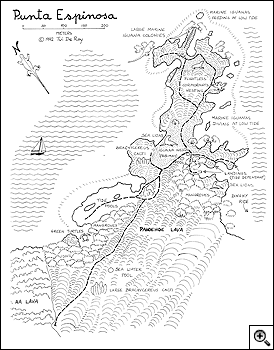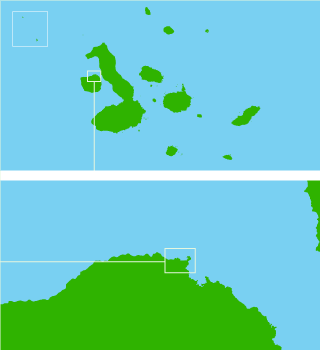

| PUNTA ESPINOZA |
Fernandina Island |

Permitted Uses:  Interpretive Group Tour with a Naturalist Guide Interpretive Group Tour with a Naturalist Guide  Photography and filming Photography and filming  Guided walks Guided walks  Associated Activities authorized by the GNPS in the itineraries of Authorized Vessels Associated Activities authorized by the GNPS in the itineraries of Authorized Vessels

|
Fernandina is the third largest island in the archipelago and has a single visitor site: Punta Espinoza, located at the northeastern tip of the island.
Punta Espinoza is a narrow ledge of lava and sand that extends from the base of the volcano to the sea. There is a vivid description given by Captain Benjamin Morrell that from its anchorage at Bay Banks witnessed and recorded an eruption of Fernandina in the decade of the 1820s that probably gave rise to the Point. In 1975, there was an uprising, about 90 cm, which is why the pier built for landing can only be used during high tide.
|
|

Click on the illustration to enlarge.
|
The last recorded eruption occurred in May 2005 that lasted three days. The greatest explosive eruption was in 1968, where two thirds of the caldera floor collapsed inwards to a depth of 300m. Later there have been eruptions in 1972 and 1973 (mild and effusive) in 1977 (the collapse of the caldera), in 1986 (mild activity), and 1988 (collapse of the south-east side), in November 1991 (cloud of ash - eruption), 1995 (spewed along a fissure).
Punta Espinoza is a place famous for its large colonies of marine iguanas and as the habitat of unique species like the flightless cormorant, Galapagos penguin, Galapagos hawk, Galapagos snake, among others. It is an ideal place to observe the lava cactus (Brachycerus nesioticus), which grow on young lava and survive with little water.
In the past two land iguanas could be found at this site, but in 1989 they died of starvation. These iguanas came down from the flanks of the volcano, where they are numerous.
In 1825 an American ship, the Tartar, was anchored in Bay Banks and witnessed a very strong eruption at Fernandina. The lava reached the sea and the air temperature rose to 50 ° C and the sea at 40 ° C. After being caught in the bay for a whole night, the ship escaped southward and while they passed through Fernandina the temperature rose to 65 ° C, the tar of calafeteado of the ship began to leak and melt. Two weeks later Fernandina was still active.
Special Indications
-
Fernandina is the only island, which has no introduced mammals. Be careful not to introduce organisms or take food of any kind. The area open to visitors is very fragile, stay on the trail at all times.
-
At the nesting season for marine iguanas (January to June) its important that one be careful not to step on their nests (holes in the sand). These reptiles nest in the sand and sometimes cover the entire area.
-
Stay within 2m of the cormorants and penguins.
- Land when the tide is high, if the tide is low you can not use the dock, you have to land on the rocks.
|


![]()


![]()